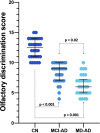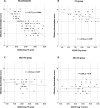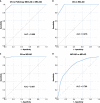Odor Discrimination as a Marker of Early Alzheimer's Disease
- PMID: 37355894
- PMCID: PMC10473073
- DOI: 10.3233/JAD-230077
Odor Discrimination as a Marker of Early Alzheimer's Disease
Abstract
Background: Olfactory dysfunction is an early symptom of Alzheimer's disease (AD). However, olfactory tests are rarely performed in clinical practice because their diagnostic efficacy in detecting early AD is unclear.
Objective: To investigate odor discrimination in patients with early AD and the efficacy of olfactory discrimination tests in differentiating these patients from subjects with normal cognition (CN).
Methods: Thirty patients each with mild dementia due to AD (MD-AD) and mild cognitive impairment due to AD (MCI-AD) and 30 older subjects with CN were enrolled. All participants underwent cognitive examinations (CDR, MMSE, ADAS-Cog 13, and verbal fluency) and odor discrimination tests (Sniffin' Sticks test, Burghart®, Germany).
Results: The MD-AD group achieved significantly worse scores on the olfactory discrimination test than the MCI-AD group, and the MCI-AD group achieved significantly worse results than the CN group (p < 0.05). A cut-off score of≤10 had a diagnostic accuracy of 94.44% (95% CI, 87.51-98.17%) in differentiating patients with MCI-AD/MD-AD from subjects with CN and of 91.67% (95% CI, 81.61-97.24%) in differentiating those with MCI-AD from subjects with CN. Our multinomial logistic regression model with demographic data and ADAS-Cog 13 scores as predictor variables correctly classified 82.2% of the cases (CN, 93.3%; MC-AD, 70%; MD-AD, 83.3%); on adding the olfactory discrimination score to the model, the percentage increased to 92.2% (CN, 96.7%; MCI-AD, 86.7%; MD-AD, 93.3%).
Conclusion: Odor discrimination is impaired in cases of early AD and continues to deteriorate as the disease progresses. The olfactory discrimination test showed good diagnostic efficacy in detecting early AD.
Keywords: Alzheimer’s disease; mild cognitive impairment; olfaction; olfactory impairment.
Conflict of interest statement
All authors have no conflict of interest to report.
Figures



Similar articles
-
Properties of odor identification testing in screening for early-stage Alzheimer's disease.Sci Rep. 2023 Apr 13;13(1):6075. doi: 10.1038/s41598-023-32878-w. Sci Rep. 2023. PMID: 37055436 Free PMC article.
-
Brief Test of Olfactory Dysfunction Based on Diagnostic Features of Specific Odors in Early-Stage Alzheimer Disease.Med Sci Monit. 2023 May 27;29:e940363. doi: 10.12659/MSM.940363. Med Sci Monit. 2023. PMID: 37243326 Free PMC article.
-
Olfactory Dysfunction Is Already Present with Subjective Cognitive Decline and Deepens with Disease Severity in the Alzheimer's Disease Spectrum.J Alzheimers Dis. 2021;79(2):585-595. doi: 10.3233/JAD-201168. J Alzheimers Dis. 2021. PMID: 33361601
-
Olfactory function in mild cognitive impairment and Alzheimer's disease: A meta-analysis.Laryngoscope. 2019 Feb;129(2):362-369. doi: 10.1002/lary.27399. Epub 2018 Nov 22. Laryngoscope. 2019. PMID: 30565695 Review.
-
Olfactory Identification Deficits, Cognitive Decline, and Dementia in Older Adults.Am J Geriatr Psychiatry. 2016 Dec;24(12):1151-1157. doi: 10.1016/j.jagp.2016.08.010. Epub 2016 Aug 17. Am J Geriatr Psychiatry. 2016. PMID: 27745824 Free PMC article. Review.
Cited by
-
Olfactory dysfunction as potential biomarker in neurodegenerative diseases: a narrative review.Front Neurosci. 2025 Jan 7;18:1505029. doi: 10.3389/fnins.2024.1505029. eCollection 2024. Front Neurosci. 2025. PMID: 39840019 Free PMC article. Review.
-
An experimental framework for conjoint measures of olfaction, navigation, and motion as pre-clinical biomarkers of Alzheimer's disease.J Alzheimers Dis Rep. 2024 Dec 23;8(1):1722-1744. doi: 10.1177/25424823241307617. eCollection 2024. J Alzheimers Dis Rep. 2024. PMID: 40034341 Free PMC article. Review.
-
Elevated tau in the piriform cortex in Alzheimer's but not Parkinson's disease using PET-MR.Alzheimers Dement (Amst). 2024 Nov 23;16(4):e70040. doi: 10.1002/dad2.70040. eCollection 2024 Oct-Dec. Alzheimers Dement (Amst). 2024. PMID: 39583648 Free PMC article.
-
The AROMHA brain health test is a remote olfactory assessment to screen for cognitive impairment.Sci Rep. 2025 Mar 24;15(1):9290. doi: 10.1038/s41598-025-92826-8. Sci Rep. 2025. PMID: 40128240 Free PMC article.
-
Minding the Gap: Exploring Neuroinflammatory and Microglial Sex Differences in Alzheimer's Disease.Int J Mol Sci. 2023 Dec 12;24(24):17377. doi: 10.3390/ijms242417377. Int J Mol Sci. 2023. PMID: 38139206 Free PMC article. Review.
References
-
- World Health Organization (2021) Global Status Report on thePublic Health Response to Dementia. World Health Organization, Geneva. License: CC, BY-NC-SA3.0 IGO.
-
- Gauthier S, Rosa-Neto P, Morais JA, Webster C (2021) World Alzheimer Report 2021: Journey through the Diagnosis of Dementia, Alzheimer’s Disease International, London, England.
-
- World Health Organization (2017) Global Action Plan on the Public Health Response to Dementia 2017–2025. World Health Organization, Geneva. License: CC BY-NC-SA 3.0 IGO.
-
- Albert MS, DeKosky ST, Dickson D, Dubois B, Feldman HH, Fox NC, Gamst A, Holtzman DM, Jagust WJ, Petersen RC, Snyder PJ, Carrillo MC, Thies B, Phelps CH (2011) The diagnosis of mild cognitive impairment due to Alzheimer’s disease: Recommendations from the National Institute on Aging-Alzheimer’s Association workgroups on diagnostic guidelines for Alzheimer’s disease. Alzheimers Dement 7, 270–279. - PMC - PubMed
-
- McKhann GM, Knopman DS, Chertkow H, Hyman BT, Jack CR Jr, Kawas CH, Klunk WE, Koroshetz WJ, Manly JJ, Mayeux R, Mohs RC, Morris JC, Rossor MN, Scheltens P, Carrillo MC, Thies B, Weintraub S, Phelps CH (2011) The diagnosis of dementia due to Alzheimer’s disease: Recommendations from the National Institute on Aging-Alzheimer’s Association workgroups on diagnostic guidelines for Alzheimer’s disease. Alzheimers Dement 7, 263–269. - PMC - PubMed
MeSH terms
LinkOut - more resources
Full Text Sources
Medical

